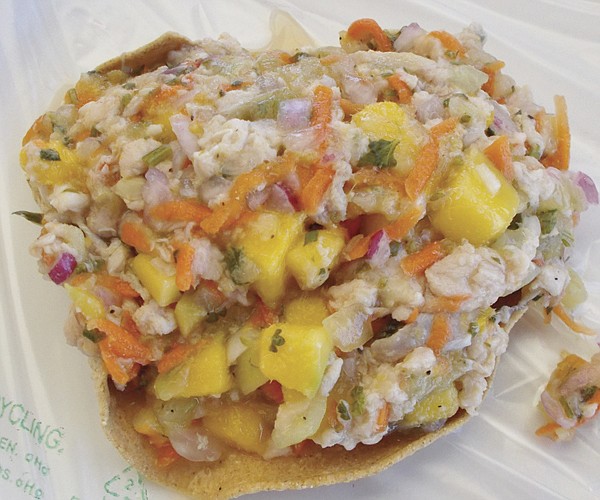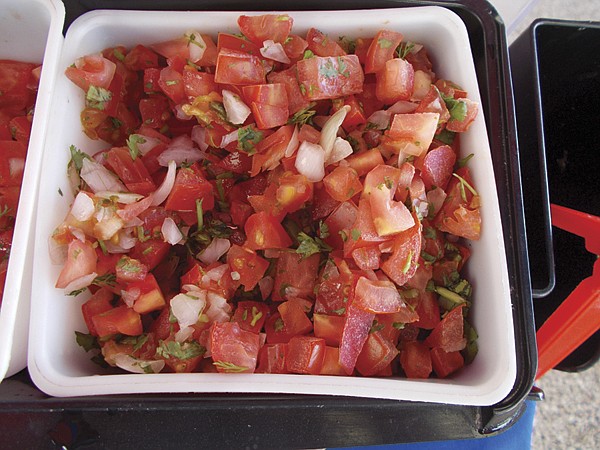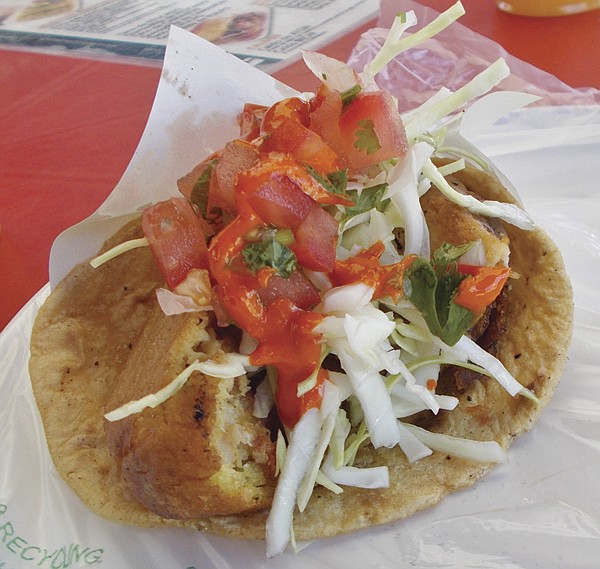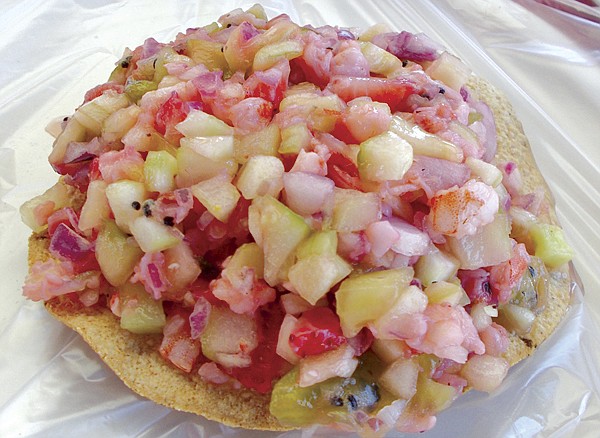 Facebook
Facebook
 X
X
 Instagram
Instagram
 TikTok
TikTok
 Youtube
Youtube

I’d kinda forgotten about the Mexican custom of eating lunch late. It’s 4:00 in the afternoon, and I’m starving.
“Jump in.”
At last. This is my TJ buddy, Héctor, rolling up in his “Atos, by Dodge.” It also has the Hyundai-badge Indian design, says Héctor, made in Mexico. It’s a compact. Wow. Talk about world economy. Not sold in the U.S.
He drives us through the Río part of Tijuana, to a side street called Rosario Castellanos. It’s dusty; it seems only partially paved.
“There’s an eatery here?” I ask.

“We just passed it,” he says. He turns into a crowded parking lot, parks, hops out. I follow him through a little gate in a fence that surrounds a food truck.
“Yes, we’re open!” reads a banner (in Spanish).
We walk past it and under a big red, white, and blue canopy, partially walled in by blue canvas sides. A dozen red plastic tables sit on gravel in the shade.
Héctor tells me that two brothers and their father opened this place up a year ago. “They are all about seafood,” Héctor says. “It’s modest, but people know they make great fillings for their tacos. Sort of seafood stews. Estofados. They’re part of what’s happening.”
“You mean, since the ’08 crash, crime, no tourists, all that?”
“Yes. It’s quite a phenomenon. After the financial bottom fell out — and it really did — people started looking back, to find how they had survived pre–Burger King. People here discovered whole ways of life they had left behind. Instead of burgers and hot dogs, they took more interest in our own food traditions. Maybe it’s like your locovore movement. But people like Diego and Mauricio and their dad, Raúl, started getting interested in native traditions. Spices, fruits, vegetables…I don’t even know half of what’s going on. But they’re making real interesting tacos.”
We come into the big open graveled area and sit down at one of the red plastic tables. A tall guy in jeans and a black T-shirt crunches up to us with menus. He’s Diego.

“Some drinks?” Diego asks. “Coca-Cola, tea, fruit drinks? We have a good pineapple and celery.”
Pineapple and celery? Together? Sounds interesting. I go for that ($1.50). Héctor gets a straight mango juice ($1.50).
The food is basically tacos or tostadas or tortas or quesadillas that feature tuna or marlin or shrimp or other seafood: it’s the combos that are original. Héctor takes the first shot with a fish-and-mango tostada (20 pesos; about $1.50). It has carrots, onions, lime juice, tomato.
I match him with a strawberry-kiwifruit-shrimp tostada with cucumber (30 pesos; about $2).
They are fresh and tasty and definitely healthy. And that celery in my piña drink takes the sugary edge off.
But this is just the beginning. The afternoon becomes something like a long, leisurely drinking session, only with food.
The next thing we have to have is the “naked” soup, the Caldo Bichi. “Bichi is slang for ‘naked,’” Diego says. “This soup is for levanta muerta — bringing you back from the dead — a hangover — or for warming up on cold days. It’s the flavors from tuna carcasses cooked with celery, carrots, olives, and onions. It’s also good for stimulating your appetite.”
“It says it’s done ‘cahuatun’ — in the style of turtle soup,” says Héctor. Because killing turtles is forbidden, this is tuna soup, ‘in the style of’ the old, much-loved traditional turtle soup.”

Next we order tuna stew. Taco de estofada de atun ($1.75 in a corn tortilla or $4 in a torta). It’s a rich, garlicky, adobo-like stuffing that I could eat all day. But then Hector starts asking about the taco de pulpo: octopus. Oh, yeah. I’m starting to understand the system here. You can have tacos or quesadillas with fish, shrimp, or octopus with any of seven different guisados — stews cooked in butter and white wine. Like, the poblano or the ajillo. Prices go from $1.25 for a fish (tuna) taco in a corn tortilla to $2.50 for an octopus quesadilla. The much bigger tortas are about $1 more.
We may be eating on gravel, but we’re talking classy tacos. This is like gastro-trucks bringing interesting gourmet eats to the food-truck world.
“Let’s go for the pesto,” Hector says.
We do, and oh, man... How delicious can this get? It doesn’t even taste fishy. It tastes, well, Italian, what with the cilantro and parmesan cheese and almond flavors.
Mauricio, Diego’s brother, comes over to check on his customers. He says he’s always loved cooking. He had this idea to start an eatery with — he points to a quote in his menu — “the most innovative ideas in high urban cooking.”
“We lived in Mexico City as kids. There’s a lot of influence from, say, the Yucatán. Our pollo pibil, marinating the chicken in bitter Seville orange juices, or chilorio from Sinaloa: pork cooked in a chili sauce. It all comes from our native history. People are interested in this again.”
And now we have to try the hottest challenge, the Endiablado. Also called the Huerfanito: the Little Orphan. It’s a hot taco, all right. Chile de árbol in there. But what’s this “little orphan” thing? And why does the menu say, “Our customers say it has no mother”?

Diego, Mauricio, and Héctor all smile. “It’s a phrase that can mean really bad things,” Héctor says. “But a bit like ‘bad’ in English, it can also mean ‘good.’”
Me, I’m breathing fire. “I know exactly what they mean,” I say.
It feels like we’ve eaten the house out. It feels like we’ve had a feast. But our eight tacos, tostadas, tortas, soup, and juices come to 221 pesos, about $16.50.
As we crunch out into the sun, over to Héctor’s Indian-designed car, I can’t help feeling that something important foodwise is happening here. Different from San Diego, but underneath, maybe, the same kind of stirrings.
Call it a “gut” feeling, heh-heh.
The Place: Mr. Tuna, Tacos de Mariscos (Calle Erasmus Castellanos, 9449, 22010 Tijuana, 011-52-664-680-2767, or 011-52-664-293-6612)
Prices: Tacos, $1.25–$2.50; Taco de estofada de atun (tuna), $1.75; $4 in a torta; fish-and-mango tostada, $1.50; strawberry-kiwifruit-shrimp tostada, $2; Caldo Bichi (“naked soup”), $1; taco de machaca de marlin, $1.25; octopus taco, $1.75
Hours: 7:30 a.m.–4:30 p.m., seven days
Taxi: $5 from the border


I’d kinda forgotten about the Mexican custom of eating lunch late. It’s 4:00 in the afternoon, and I’m starving.
“Jump in.”
At last. This is my TJ buddy, Héctor, rolling up in his “Atos, by Dodge.” It also has the Hyundai-badge Indian design, says Héctor, made in Mexico. It’s a compact. Wow. Talk about world economy. Not sold in the U.S.
He drives us through the Río part of Tijuana, to a side street called Rosario Castellanos. It’s dusty; it seems only partially paved.
“There’s an eatery here?” I ask.

“We just passed it,” he says. He turns into a crowded parking lot, parks, hops out. I follow him through a little gate in a fence that surrounds a food truck.
“Yes, we’re open!” reads a banner (in Spanish).
We walk past it and under a big red, white, and blue canopy, partially walled in by blue canvas sides. A dozen red plastic tables sit on gravel in the shade.
Héctor tells me that two brothers and their father opened this place up a year ago. “They are all about seafood,” Héctor says. “It’s modest, but people know they make great fillings for their tacos. Sort of seafood stews. Estofados. They’re part of what’s happening.”
“You mean, since the ’08 crash, crime, no tourists, all that?”
“Yes. It’s quite a phenomenon. After the financial bottom fell out — and it really did — people started looking back, to find how they had survived pre–Burger King. People here discovered whole ways of life they had left behind. Instead of burgers and hot dogs, they took more interest in our own food traditions. Maybe it’s like your locovore movement. But people like Diego and Mauricio and their dad, Raúl, started getting interested in native traditions. Spices, fruits, vegetables…I don’t even know half of what’s going on. But they’re making real interesting tacos.”
We come into the big open graveled area and sit down at one of the red plastic tables. A tall guy in jeans and a black T-shirt crunches up to us with menus. He’s Diego.

“Some drinks?” Diego asks. “Coca-Cola, tea, fruit drinks? We have a good pineapple and celery.”
Pineapple and celery? Together? Sounds interesting. I go for that ($1.50). Héctor gets a straight mango juice ($1.50).
The food is basically tacos or tostadas or tortas or quesadillas that feature tuna or marlin or shrimp or other seafood: it’s the combos that are original. Héctor takes the first shot with a fish-and-mango tostada (20 pesos; about $1.50). It has carrots, onions, lime juice, tomato.
I match him with a strawberry-kiwifruit-shrimp tostada with cucumber (30 pesos; about $2).
They are fresh and tasty and definitely healthy. And that celery in my piña drink takes the sugary edge off.
But this is just the beginning. The afternoon becomes something like a long, leisurely drinking session, only with food.
The next thing we have to have is the “naked” soup, the Caldo Bichi. “Bichi is slang for ‘naked,’” Diego says. “This soup is for levanta muerta — bringing you back from the dead — a hangover — or for warming up on cold days. It’s the flavors from tuna carcasses cooked with celery, carrots, olives, and onions. It’s also good for stimulating your appetite.”
“It says it’s done ‘cahuatun’ — in the style of turtle soup,” says Héctor. Because killing turtles is forbidden, this is tuna soup, ‘in the style of’ the old, much-loved traditional turtle soup.”

Next we order tuna stew. Taco de estofada de atun ($1.75 in a corn tortilla or $4 in a torta). It’s a rich, garlicky, adobo-like stuffing that I could eat all day. But then Hector starts asking about the taco de pulpo: octopus. Oh, yeah. I’m starting to understand the system here. You can have tacos or quesadillas with fish, shrimp, or octopus with any of seven different guisados — stews cooked in butter and white wine. Like, the poblano or the ajillo. Prices go from $1.25 for a fish (tuna) taco in a corn tortilla to $2.50 for an octopus quesadilla. The much bigger tortas are about $1 more.
We may be eating on gravel, but we’re talking classy tacos. This is like gastro-trucks bringing interesting gourmet eats to the food-truck world.
“Let’s go for the pesto,” Hector says.
We do, and oh, man... How delicious can this get? It doesn’t even taste fishy. It tastes, well, Italian, what with the cilantro and parmesan cheese and almond flavors.
Mauricio, Diego’s brother, comes over to check on his customers. He says he’s always loved cooking. He had this idea to start an eatery with — he points to a quote in his menu — “the most innovative ideas in high urban cooking.”
“We lived in Mexico City as kids. There’s a lot of influence from, say, the Yucatán. Our pollo pibil, marinating the chicken in bitter Seville orange juices, or chilorio from Sinaloa: pork cooked in a chili sauce. It all comes from our native history. People are interested in this again.”
And now we have to try the hottest challenge, the Endiablado. Also called the Huerfanito: the Little Orphan. It’s a hot taco, all right. Chile de árbol in there. But what’s this “little orphan” thing? And why does the menu say, “Our customers say it has no mother”?

Diego, Mauricio, and Héctor all smile. “It’s a phrase that can mean really bad things,” Héctor says. “But a bit like ‘bad’ in English, it can also mean ‘good.’”
Me, I’m breathing fire. “I know exactly what they mean,” I say.
It feels like we’ve eaten the house out. It feels like we’ve had a feast. But our eight tacos, tostadas, tortas, soup, and juices come to 221 pesos, about $16.50.
As we crunch out into the sun, over to Héctor’s Indian-designed car, I can’t help feeling that something important foodwise is happening here. Different from San Diego, but underneath, maybe, the same kind of stirrings.
Call it a “gut” feeling, heh-heh.
The Place: Mr. Tuna, Tacos de Mariscos (Calle Erasmus Castellanos, 9449, 22010 Tijuana, 011-52-664-680-2767, or 011-52-664-293-6612)
Prices: Tacos, $1.25–$2.50; Taco de estofada de atun (tuna), $1.75; $4 in a torta; fish-and-mango tostada, $1.50; strawberry-kiwifruit-shrimp tostada, $2; Caldo Bichi (“naked soup”), $1; taco de machaca de marlin, $1.25; octopus taco, $1.75
Hours: 7:30 a.m.–4:30 p.m., seven days
Taxi: $5 from the border
Comments